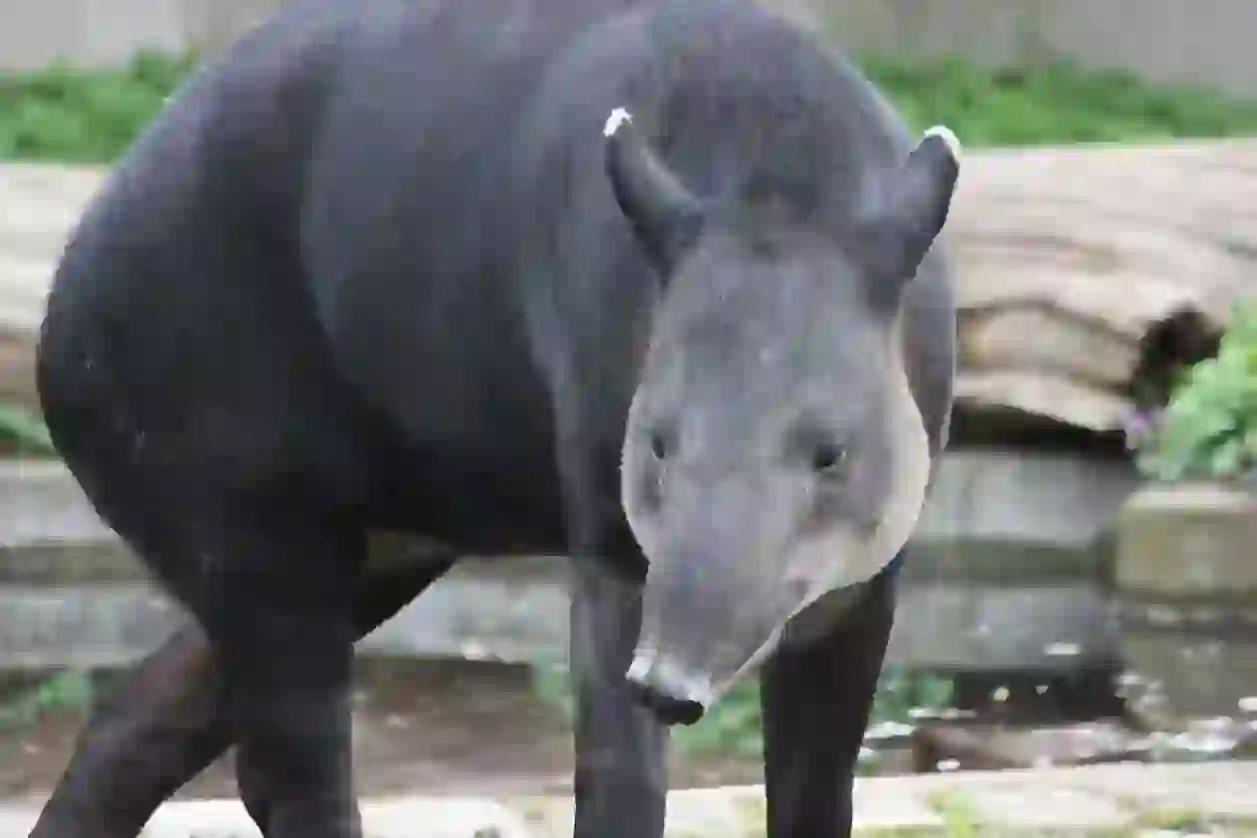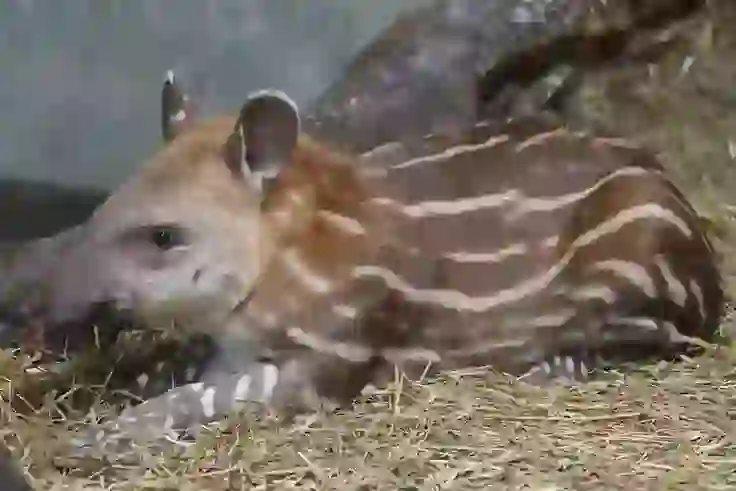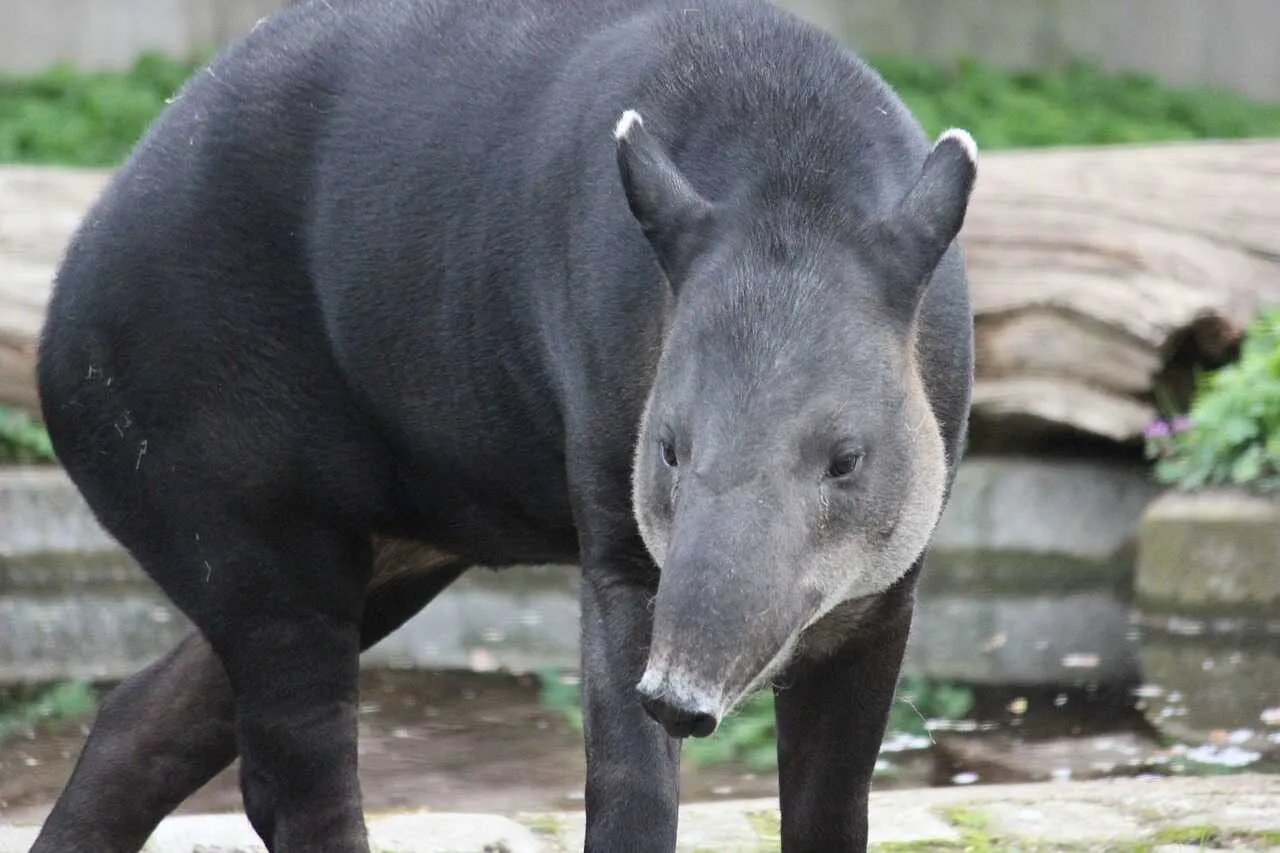
Tapir
Tapir
Tapir
Do you know the animal called 'tapir'? Some of you might think of it as a legendary creature that eats dreams. However, the tapir is a real animal, and you can see it in zoos and other places. It has a body that looks like a mix of various animals, and in this article, we will introduce you to the tapir!
Tapir Basic Infomation

Basic Information About Tapirs
Tapirs belong to the Mammalia class, Perissodactyla order, Tapiridae family, and Tapirus genus.
Body length: 1.7 to 2.5 meters
Shoulder height: 0.75 to 1.2 meters
Weight: 130 to over 340 kilograms
There are five types of tapirs within the Tapirus genus, collectively known as tapirs. They live in North America, South America, and Southeast Asia.
Tapirs have bodies suited to their environments, allowing them to avoid predators. Their bodies, like rhinos, have few bumps or protrusions, allowing them to move smoothly through bushes and forests without getting caught on branches.
Their skin is thick, with some hair, but tapirs living in colder regions have longer hair for protection against the cold. Some species have longer hair on the back of their necks to protect against predators biting their necks.
Besides body shape, the color of their bodies is also designed to help them blend in. Generally, their bodies are the same color throughout, with brown-tinged black or red-tinged black. This helps them blend into the forests and bushes to avoid predators. However, there are tapirs with two colors.

About Tapir Body Colors
The Malayan tapir is a type of tapir with a black front and back and a white middle, creating a two-color pattern.
It might seem like this would make them stand out, but think about a forest at night with only a bit of moonlight. In such an environment, the Malayan tapir appears to be split into two separate parts or only the white part is visible, making it hard for predators to see its outline. The different colors help them stay hidden.
The tapir's eyes are small and recessed into the face, protecting them from getting hurt by branches in the forest. Unlike most four-legged animals, the tapir's front legs are longer than its back legs, helping them push through tall grass.
The Perissodactyla order, to which tapirs belong, is characterized by odd-toed hooves. Tapirs have three toes on their back legs and four on their front legs, with the fourth front toe sitting slightly higher than the others.
The higher fourth toe is used only when walking on soft or muddy ground. When the ground is soft, it helps distribute the weight to avoid sinking.
One of the tapir's most distinctive features is its nose. It is connected to the upper jaw and is somewhat elongated. It has the same structure as an elephant's trunk but is shorter. The tapir's nose can extend and move freely.
Let's summarize the tapir's body. It has a body like a rhino, a nose like an elephant, internal organs like a horse's digestive system, and lungs like a cow's. This unique combination of features from these four animals creates the tapir.
Tapir Q&A

What's the origin of the tapir's name?
As mentioned earlier, the tapir shares its name with a legendary creature. One theory is that the animal was named after the legendary creature because it resembles it.
But why is the legendary creature called 'baku'? The creature's name in Chinese characters is '獏,' which means 'mixed' in Thai. The legend says that the god created this creature from leftover parts of other animals.
Interestingly, the real tapir has a body that looks like a mix of various animals. Perhaps it's called 'baku' because it resembles something mixed.
However, the name 'baku' is used only in Japan, China, and Korea. In English, it's known as 'tapir,' derived from the Tupi language of Brazil's indigenous people.

Why do tapirs live where they do?
Tapirs live in a variety of habitats depending on the species: forests, jungles, bushlands with water, rainforests, mountainous regions, grasslands, savannas, mangroves, and dry forests. Some species even live at elevations between 2,000 and 4,400 meters in the Andes Mountains.
Tapirs are mainly nocturnal, but they are active at dusk and dawn, living solitary lives. Though they generally walk slowly, they can also run or dash quickly.
They are skilled swimmers, often seen resting or bathing in water. When threatened by predators like jaguars, tigers, or leopards, they dive into the water and only expose their noses for breathing.
Tapirs can also make various sounds. They emit sharp cries to signal danger or when they are hurt. They use a 'poo-poo' sound to ward off insects when annoyed, and they may click their tongues or blow through their noses to explore or calm their young.
Because tapirs are nocturnal and live in dense jungles with poor visibility, they rely heavily on their sense of smell. They mark their territory with urine, which helps them identify the presence of other tapirs.

What do tapirs eat?
Tapirs primarily eat leaves, buds, branches, fruits, water plants, and tree bark. Depending on the species and their location, they might also eat fish, cacti, cocoa, melons, corn, and sugarcane.
Tapirs use their distinctive noses to manipulate food, pulling it toward their mouths with precision. When eating leaves, they don't strip an entire tree but take only a few leaves from one tree before moving on to the next.
This behavior might be to preserve the forest or to leave food for other animals. Tapirs use their noses in an efficient manner, ensuring they don't deplete the environment.

How do tapirs reproduce?
Tapirs reproduce annually, with calves born between April and May. They only socialize with males during the breeding season, and after birth, they form family groups.
The gestation period is about 390-400 days, and they usually give birth to one calf. Newborns can stand immediately but can only drink milk. During this time, the mother and calf spend most of their day sleeping.
For the first six months, tapirs have black coats with white stripes or spots, similar to wild boars. This coloration provides camouflage in their bushland and forest habitats.
By six months, they begin to change to adult coloration. By ten months, they switch from milk to eating leaves and other adult foods. However, they are still vulnerable to predators, and their mothers fiercely defend them by kicking.
By around eleven months, they leave their parents to live independently, but it takes about eighteen months for them to grow to adult size.

Do tapirs eat dreams?
As mentioned earlier, it's not the animal tapir but the legendary creature that is said to eat dreams. This legendary creature, called 'baku,' is a talisman used to ward off evil spirits and illnesses in ancient China.
In ancient times, people believed that spirits would steal souls while they slept. The 'baku' was used to protect against evil spirits, with images or figurines placed by the bedside to ensure safe sleep.
When the concept spread to Japan, it transformed from 'warding off evil spirits' to 'eating bad dreams.' People began to say phrases like, 'I give last night's dream to the baku' to ward off bad dreams.
During the Edo period, people would place pictures of treasure ships under their pillows for good luck and write the word 'baku' to ward off bad dreams. This concept became popular, with merchants selling pillows decorated with 'baku.'
Descriptions of the legendary 'baku' vary greatly. Some say it had a bear-like body with a small head, black and white patches, and ate metal and bamboo. Others described it as having an elephant's nose, a rhino's eyes, a cow's tail, and tiger-like legs.
Some theorize that these descriptions refer to different animals, like giant pandas or Malayan tapirs. It’s uncertain what the real origin of these legends is, but the important thing is the belief and symbolism behind them.
Interestingly, a bronze artifact from ancient China was found that resembles the animal tapir. This suggests that tapirs might have lived in ancient China and became part of these legends after going extinct.

Are tapirs endangered?
Out of the five existing tapir species, four are considered endangered.
Tapirs used to inhabit Europe, Asia, and all of America, with their history dating back 12 million years. They were highly revered by ancient people and considered symbols of faith.
However, tapir populations have decreased significantly due to deforestation for farming, dam construction, and human habitation. Tapirs were also hunted for their high-quality fur and for meat consumption.
Additionally, tapirs are often seen as pests because they eat crops like cocoa, corn, and sugarcane, leading farmers to kill them.
The current estimated wild population is around 900 to 3,000 individuals, a small number compared to their previous abundance.
In 2013, a new tapir species, the Kabomani tapir, was discovered in Brazil and Colombia, indicating that there might be more undiscovered tapirs out there.
While the tapir population is small, we can still help by protecting their habitats and minimizing hunting to prevent further declines.

Would you like to become a part of the 'Animalbook.jp'?
Turn your knowledge into Q&A and share it with the world. ※Publication will be activated after purchase. Let's share information together!
Tapir Type of List

Types of Tapirs and the Red List
- Baird's Tapir: Endangered (IUCN Red List Category IB)
- Malayan Tapir: Endangered (IUCN Red List Category IB)
- Mountain Tapir: Endangered (IUCN Red List Category IB)
- Brazilian Tapir: Vulnerable (IUCN Red List Category II)
- Kabomani Tapir (New Species)
Information
Congratulations! You are the first commenter!

Create Your Favorite List!
Tapir
Save the animals you love! Build your own list to quickly revisit your favorites later.

Would you like to leave a comment?
※Please note: This is for the purchase of rights to post comments within the article.
Find Your Favorites!
Our shop offers a unique and attractive selection of goods themed around various animals.
Tapir References
Tapir Introduction of media used
Pixabayが提供するEmrah Aktaşの動画

Renato CanepaによるPixabayからの画像

Marcel LangthimによるPixabayからの画像

Donna B. McNicolによるPixabayからの画像

Jana V. M.によるPixabayからの画像

Help Enrich Our Animalbook.jp with Your Media!
We are constantly looking to expand and enrich our Animalbook.jp with amazing photos and videos of animals. If you have any media that you'd like to share, please contribute and help us showcase the beauty and diversity of the animal kingdom. Your submissions will be credited and featured in our encyclopedia, reaching a wide audience of animal lovers.


















